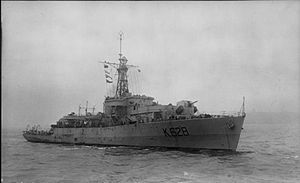 Loch Killisport in July 1945
| |
| History | |
|---|---|
| Name | HMS Loch Killisport |
| Namesake | Loch Killisport |
| Ordered | 2 February 1943 |
| Builder | Harland and Wolff, Belfast |
| Yard number | 1248 |
| Laid down | 28 December 1943 |
| Launched | 6 July 1944 |
| Completed | 9 July 1945 |
| Commissioned | July 1945 |
| Decommissioned | April 1946 |
| Recommissioned | November 1950 |
| Decommissioned | April 1952 |
| Recommissioned | February 1955 |
| Decommissioned | August 1965 |
| Fate | Sold for scrapping, 20 February 1970 |
| General characteristics | |
| Class and type | Loch-class frigate |
| Displacement | 1,435 long tons (1,458 t) |
| Length | 307 ft 9 in (93.80 m) |
| Beam | 38 ft 9 in (11.81 m) |
| Draught | 8 ft 9 in (2.67 m) |
| Propulsion |
|
| Speed | 20 knots (37 km/h; 23 mph) |
| Range | 9,500 nmi (17,600 km) at 12 kn (22 km/h; 14 mph) |
| Complement | 114 |
| Armament |
|
HMS Loch Killisport (K628/F628) was a Loch-class frigate of the British Royal Navy, named after Loch Killisport (Scottish Gaelic: Caolisport) in Scotland. Launched in 1944, the ship was not commissioned until July 1945, and served in post-war repatriation operations in the Far East until decommissioned in April 1946. During this time Prince Philip was an officer on board this ship. Recommissioned in 1950 she served in the Home Fleet for two years, before being extensively modernised for service in the Persian Gulf and Far East. Decommissioned in August 1965, she was sold for scrapping in 1970.[1]